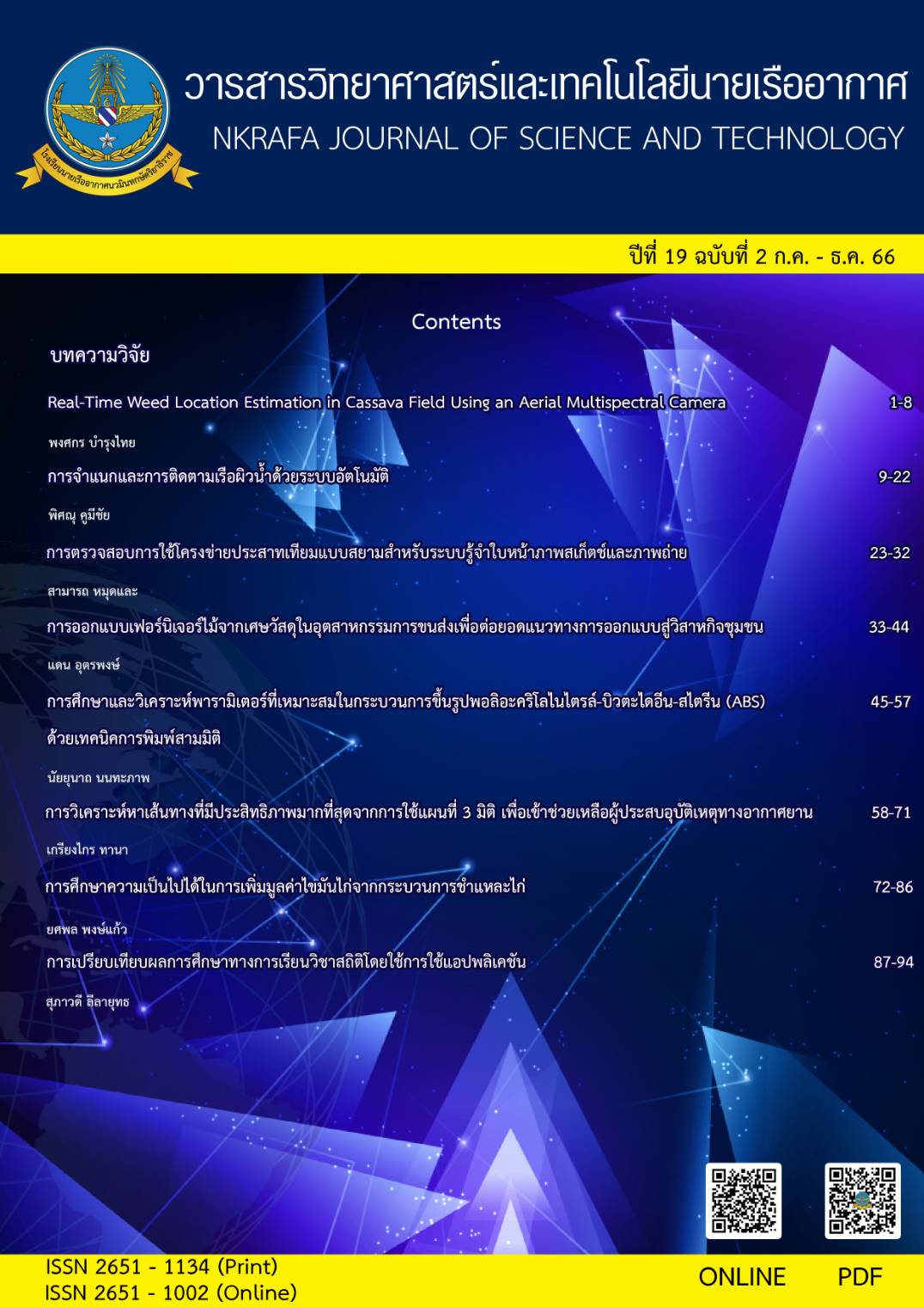Comparisons of Achievement of Statistics using Applications
Main Article Content
Abstract
The purpose of this research is to compare the study Navaminda Kasatriyadhiraj Royal Air Force Academy students from teaching by the traditional lecture method in the academic year 2020/2021 with the application of an application for learning in the academic year 2021/2022. The samples used in this research were 18 air cadets studying engineering statistics, academic year 2021/2022. Statistical analysis was done in terms of mean, standard deviation, and t-test. The results showed that air cadets who used the application to study received higher test scores than air cadets who received the traditional lecture method. at a statistically significant level.
Article Details

This work is licensed under a Creative Commons Attribution-NonCommercial-NoDerivatives 4.0 International License.
- Content and information in articles published in NKRAFA Journal of Science and Technology are comment and responsibility of authors of articles directly. Journal editorial do no need to agree or share any responsibility.
- NKRAFA Journal of Science and Technology Articles holds the copyright of the content, pictures, images etc. which published in it. If any person or agency require to reuse all or some part of articles, the permission must be obtained from the NKRAFA Journal of Science and Technology.
References
ชินวัจน์ งามวรรณากร. (2562). การพัฒนาแอปพลิเคชันสื่อการเรียนรู้บนอุปกรณ์เคลื่อนที่ เรื่อง ภาษาอังกฤษสำหรับนักสารสนเทศ. (รายงานวิจัย, มหาวิทยาลัยราชภัฏยะลา).
ตวงพร ชัยแก้ว. (2560). ปัจจัยที่มีผลต่อผู้ใช้สมาร์ตโฟนในกรุงเทพมหานครในการเลือกโปรแกรมประยุกต์สำหรับโทรศัพท์เคลื่อนที่. (วิทยานิพนธ์มหาบัณฑิต, มหาวิทยาลัยเชียงใหม่).
พรชัย มูลแก้ว. (2559). การพัฒนาสื่อแอปพลิเคชันโทรศัพท์มือถือ Android ในรายวิชาการเขียนโปรแกรมเชิงวัตถุด้วยเทคโนโลยีจาวา. เชียงใหม่: มหาวิทยาลัยเชียงใหม่.
ภาณุวัฒน์ วรพิทย์เบญจา และคณะ. (2558). การพัฒนาแอปพลิเคชันการจัดการเรียนการสอนในห้องเรียนเสมือนจริงบนอุปกรณ์เคลื่อนที่. วารสารวิชาการ คณะเทคโนโลยีอุตสาหกรรม มหาวิทยาลัยราชภัฏลำปาง. 8(2): 58-67.
ศิริญญา หล้าเต็น. (2560). การออกแบบแอปพลิเคชันบนมือถือตามแนวคิดของบลูมปรับใหม่. วารสารวิทยาการวิจัยและวิทยาการปัญญา. 15(2): 1-11.
อุบลรัตน์ ศิริสุขโภคา. (2562). การพัฒนาโมบายแอปพลิเคชันเพื่อเสริมทักษะการอ่านออกเสียงภาษาอังกฤษสำหรับนักเรียนชั้นประถมศึกษาปีที่ 3 ที่เรียนด้วยเทคนิคการเรียนแบบห้องเรียนกลับด้าน. วารสารวิชาการครุศาสตร์อุตสาหกรรม. 10(2): 227-236.
สำนักงานสถิติแห่งชาติ. (ม.ป.ป.). ประโยชน์ของข้อมูลสถิติ. สืบค้น 2 มกราคม 2566, จาก http://service.nso.go.th/ nso/nsopublish/know/estat2_2.html
อลิสา สุขแก้ว. (2561). Mobile Application คืออะไร และมีประโยชน์อย่างไร. สืบค้น 2 มกราคม 2566, จากhttps://www.mindphp.com/forums/viewtopic.php?f=198&t=45583
Benjamin S. Bloom, Max D. Engelhart, Edward J. Furst, Walker H. Hill, และ David R. Krathwohl. (2499). Taxonomy of Educational Objectives: The Classification of Educational Goals. Handbook 1. New York: David McKay.
Gwo-Jen Hwang, & Po-Han Wu. (2557). Applications, impacts and trends of mobile technology-enhanced learning: a review of 2008–2012 publications in selected SSCI journals. International Journal of Mobile Learning and Organisation, 8(2):83 - 95
Janet Mannheimer Zydney, & Zachary Warner. (2559). Mobile apps for science learning: Review of research. Computers & Education, 1-17.
Lorin W. Anderson, & David R. Krathwohl. (2554). A taxonomy for learning, teaching, and assessing: A revision of Bloom's taxonomy of educational objectives. New York: Longman.


